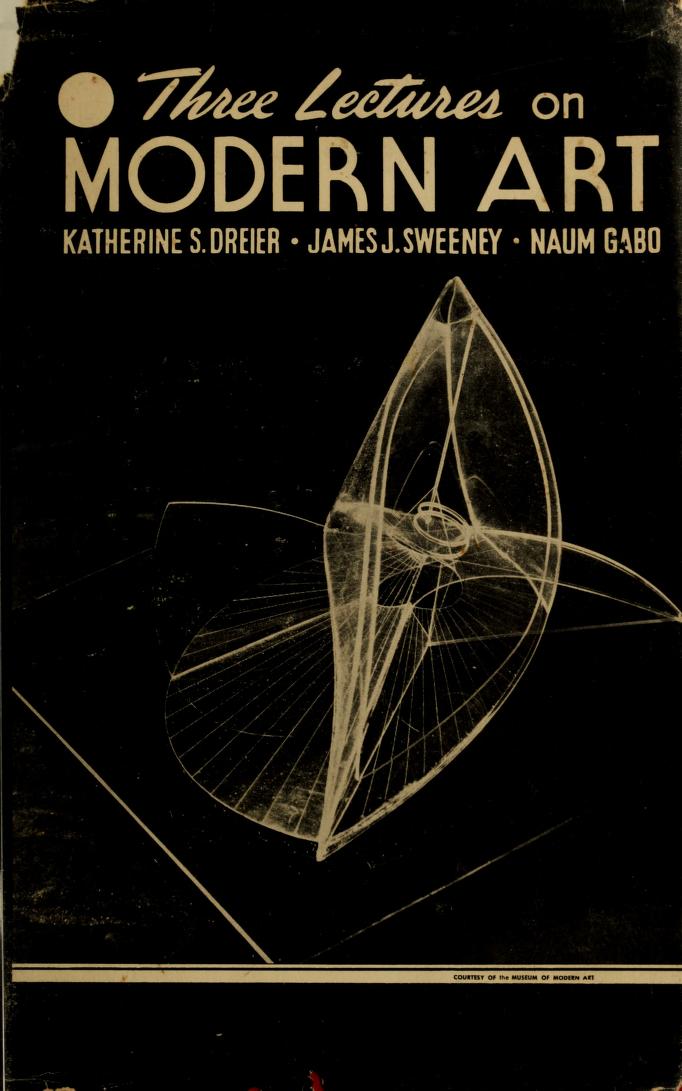Katherine S. Dreier, James Johnson Sweeney, Naum Gabo: Three Lectures on Modern Art (1949)
Filed under book | Tags: · abstract art, art, art criticism, avant-garde, constructivism, painting

“These lectures by three brilliant leaders in Modern Art were delivered at Yale University under the auspices of the Thomas Rutherford Trowbridge Art Lecture Foundation.
These three lectures deal with the founding of the Société Anonyme; Museum of Modern Art; 1920, which was organized by Katherine S. Dreier, Marcel Duchamp and Man Ray to bring clarity and understanding to the confusion which the many new forms of expression in art brought over by the Armory Exhibition in 1913 had caused.”
The lectures include “Intrinsic Significance” in Modern Art by Katherine S. Dreier. Modern Art and Tradition by James Johnson Sweeney, and A Retrospective View of Constructive Art by Naum Gabo.
Foreword by Dean Charles Sawyer
Publisher The Philosophical Library, 1949
91 pages
PDF
Internet Archive (multiple formats)
László Moholy-Nagy: The Art of Light (2010) [Spanish]
Filed under book, catalogue | Tags: · art, avant-garde, bauhaus, constructivism, film, graphic design, light art, painting, photography, sculpture, typography

An artist and thinker of astounding energy and ability, Laszlo Moholy-Nagy was a true world citizen of the early twentieth century, an ambassador-at-large for Constructivism, Suprematism, Dada and the Bauhaus. He brought the same Constructivist optimism to every medium he tackled, from plexiglass and light sculpture to typography to his photographic experiments in color to his Suprematist canvases, his influential pedagogy at the Bauhaus and at the Institute of Design in Chicago. Moholy-Nagy’s concept of the arts as a totality, his pedagogy and his confidence in the new industrial culture that would level distinctions between art and craft led him into all fields of creative production. The ultimate modernist Renaissance man, Moholy-Nagy was prolific in so many realms that his detractors inevitably charged him with dilettantism. This accusation ignores his very real innovations in photography–for example his photograms–and light sculpture, as well as the fact that the artist’s aims possessed a conceptual unity in their common aspiration to make an “art of light.”
László Moholy-Nagy: The Art of Light presents Moholy-Nagy’s work in all of its glorious unity and diversity. Including more than 200 works, from painting, photography (black and white and color) and photograms to collages, films and graphic design, it emphasizes his greatest years of productivity, from 1922 to the end of his life. The Art of Light is the new definitive volume on this hero of modernism.
László Moholy-Nagy: El Arte de la Luz
Book coordination: Doménico Chiappe, Luisa Lucuix
Editor: Emilio Ruiz Mateo
Publisher: La Fábrica Editorial / Círculo de Bellas Artes, Madrid
ISBN: 8492841257, 9788492841424
264 pages
exhibition (Madrid, 2010)
Comment (0)Alessandro Colizzi: Bruno Munari and the Invention of Modern Graphic Design in Italy, 1928-1945 (2011)
Filed under thesis | Tags: · 1920s, 1930s, 1940s, art, avant-garde, constructivism, design, futurism, graphic design, italy, painting, typography

“Despite the difficult political conditions under the Fascist regime, Italy saw its own modernist wave hit the commercial arts in the 1930s, resulting from a complex interplay of factors as diverse as the weight of Futurism, the rise of advertising, and the debate surrounding Rationalist architecture. This research examines Bruno Munari’s work as a graphic designer from the late 1920s to mid-1940s, with the aim of understanding the emergence and characteristics of the modernist trend in Italian graphic design. Taking shape in Milan, this original ‘design culture’ eclectically brought together two quite different strains of Modernity: a local tradition represented by the Futurist avant-garde, and a European tradition associated with Constructivism. Munari (1907–1998) worked simultaneously as painter and as advertising designer: he debuted with the Futurists, whose broader cultural reach he shared, while also remaining open to other currents—such as Dadaism and Surrealism—and ultimately aligned himself with a more Abstractionist stance. Insofar as he was an exponent of the new advertising profession, his design work also reflects its evolution, mixed references, aspirations, and limits. Concentrating on Munari’s stylistic development, the study seeks to explore the interaction between the Futurist visual vocabulary and conceptions coming from architecture, photography, abstract painting, and functionalist typography trickling in from central and northern Europe. Hence, the discussion positions the designer in his time and place, concentrating as much on the artefacts as on the broader cultural framework. Secondly, the study attempts to assess Munari’s reputation against a body of exemplary work, based on firsthand documentation. It is the first extensive, detailed record of Munari’s graphic design output, and as such provides a substantial base for a full understanding of his œuvre. While Munari’s evolution is dealt with chronologically, the analysis of his graphic works highlights key areas of visual interest, offering a cross reading that sheds light on their underlying poetics, themes, and formal attributes. In its trajectory, Munari’s wide-ranging graphic design work shows how modernist ideas were received and assimilated in the Milanese environment of the 1930s, as well as the shift in conceptions of the graphic design profession—from one related to avant-garde art practice to a Modern one, based on rational idioms. The roots of modern Italian graphic design, which fully emerged after 1945, can be traced to this heterogeneous legacy—and it is no coincidence that Munari became one of the fields’ leading exponents.” (Abstract)
Doctoral Thesis
Faculty of Humanities, Leiden University Academy of Creative and Performing Arts
Promotor: G. Unger
Co-promotor: T.M. Eliëns
PDF (Works section missing)
PDFs

